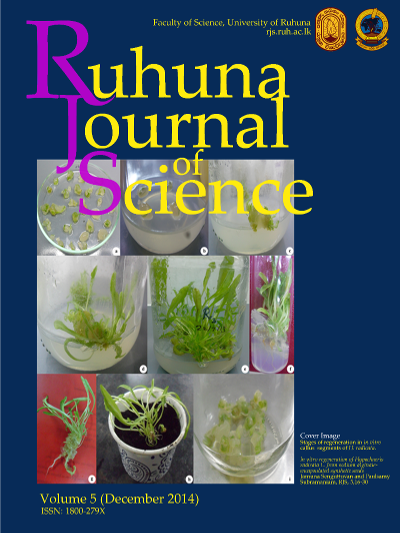Prelimnary phytochemical studies in the leaf, stem and root extracts of the traditional medicinal plant species, Thalictrum Javanicum Blume
Abstract
Abstract.           The leaf, stem and root parts of the traditional medicinal plant species, Thalictrum javanicum are effectively used against the disorder, haematuria and the roots are prescribed as  diuretic, purgative and tonic by the local healers of high hills of Nilgiris, the Western Ghats, India. As there is no work in phytochemical constituents, the present study was aimed at to know the available major secondary metabolites in the study species, T. javanicum by preliminary analysis including TLC. The results of the study report the presence of the many major secondary metabolites viz., tannins, saponins, resins, flavonoids, alkaloids, glycosides, terpenoids, cardiac glycosides and triterpenoids in the three parts studied altogether. Among the alcoholic solvents attempted, the methanol extract contained rich number of secondary metabolites than the other solvents used. The mobile phases for the separation of various secondary metabolites were also standardized. The presence of different varieties of secondary metabolites of medicinal importance confirmed the traditional knowledge of local healers of high hills of Nilgiris on medicinal uses of this species.Key words: Thalictrum javanicum, secondary metabolites, TLC.References
References
Allan L and Millen N.D. 1996. Antioxidant flavonoids: Function and Clinical Usage . Alt Med Rev., 1(2): 109-111.
Bahadur S and Shukla Ak, 1983. Studies on medicinal plants I, the Quartenary alkaloids of Thalictrum javanicum. J.Nat.Prod. 1983; 46(4): 454-457.
Brindha PK, Sasikala and Purushoth K. 1977. Prelimnary phytochemical studies in higher plants. Ethnobot-3. 84-96.
Chen, S., Chen,S and Xiao P. 2003. Ethnopharmacological
investigations on Thalictrum plants in China. Journal of Asian Natural Product. Research , 5(4); 263-271.
Eloff JNC.1998. Which extractant should be used for the screening and isolation of antimicrobial components from plants? J. Ethanopharmacol; 60:1-8.
Harbone JB. 1988. Phytochemical methods. A guide to Mordern Technique of plant analysis (3rd Edn) Chapman and Hall, London.1-138.
Khamidullinia, E.A., Gromova, A.S., and Lutsky VI Owen NL. 2006. Natural products from medicinal plants: non alkaloidal natural conatituents of the Thalictrum species. Nat. Prod.Rep. 23: 117-129.
Okokon, J.E., Ofodum, K.C., Ajibesin, K.K,, Danlandi,B and Gamaneil K.S. 2005. Prelimnary pharmacological screening and evaluation of antiplasmadial activity of Croton zambesicus against P. berghei berghei infection in mice. Ind.J.Pharmacol., 37(4): 243-246.
Owoyele, B.Y.,.Olayele, S.B and R.A. Elegba. 2002. Anti-Inflammatory and analgesic activities of leaf extract of Landolphia owariensis . Afr J Biomed Res., 4(3): 131-133.
Paulsamy, S. 2009. Annual Progress Report, Ministry of
Environment and Forests, Government of India, New Delhi sponsored project, “Evaluation of conservation strategies for the sustainable utilization of herbaceous bioresources in the sholas of Nilgiris, the Western Ghats†(File No. 08/ 16/03.CS /BR) .
Sahei, M., Sinha, SC., Ray,A B., Chahopadhyay,S K., Khalil, S A., Slaticin,J D and Schiff,P LJ. 1985. Addition alkaloids of Thalictrum javanicum. J.Nat.Prod.; 48(4): 669-669.
Sharma, O. P. 2009. Plant Taxonomy. 2nd edition. Tata McGraw Hill Education Private Limited, New Delhi. 2009; 564.
The Wealth of India, 1976. Raw materials, (Vol X,Sp-W). Publications and Information Directorate, CSIR, New Delhi; 201-207.
Tiwari, Lalit and Pande P. C. 2006. Indigenous vetinary practices of Darma valley of Pithoragarh district, Uttaranchal. Indian Journal of Traditional Knowledge, 5(2): 201-206.
Wagner Hm, Bladt S, Zgainski EM. 1998. Plant drug analysis-A Thin layer chromatography Atlas- Springer Verlog Berlin.1984.
Downloads
Published
Issue
Section
License
From Volume 7 (2016) onwards, all articles published in Ruhuna Journal of Science are Open Access articles published under the Creative Commons CC BY-NC 4.0 International License. This License permits use, distribution and reproduction in any medium, provided the original work is properly cited and is not used for commercial purposes.
Copyright on any research article published in RJS is retained by the respective author(s).
Authors who publish with this journal agree to the following terms:
a) Authors retain copyright and grant the journal right of first publication with the work simultaneously licensed under a Creative Commons Attribution License CC-BY-NC 4.0 International, that allows others to share the work with an acknowledgement of the work's authorship and initial publication in this journal.
b) Authors are able to enter into separate, additional contractual arrangements for the non-exclusive distribution of the journal's published version of the work (e.g., post it to an institutional repository or publish it in a book), with an acknowledgement of its initial publication in this journal.
c) Authors are permitted and encouraged to post their work online (e.g., in institutional repositories or on their website) prior to and during the submission process, as it can lead to productive exchanges, as well as earlier and greater citation of published work (See The Effect of Open Access).

